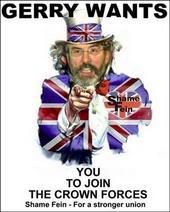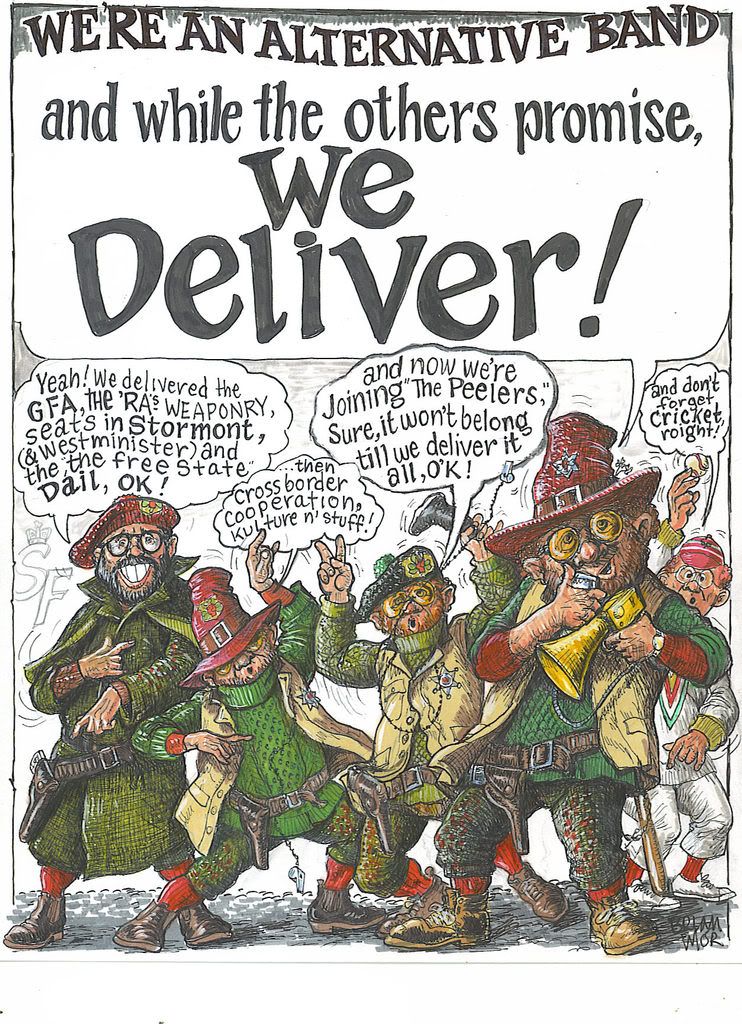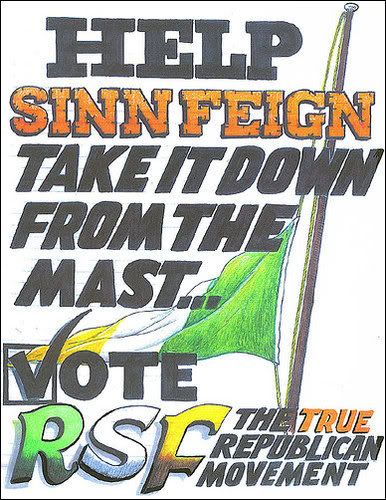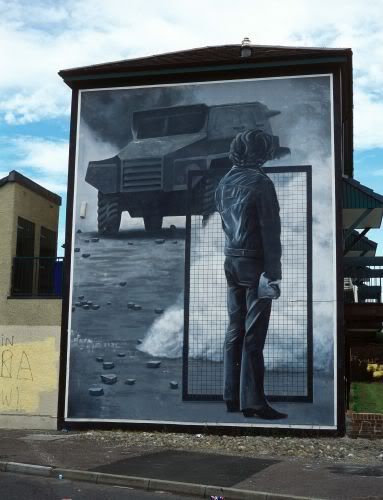[This is from the IRSM E-List, thanks TJ]
Today The Pensive Quill carries an article by guest writer, Liam O Ruairc,
on the topic of dissident republicans.
Defining Dissidents by Liam O Ruairc
If it easy to identify those that the media refers to as ‘dissident republicans’ (1) it is far more difficult to identify and define what they mean by ‘dissident republicanism’ . For example, a major reference book such as Sydney Ellliott and W.D. Flackes’s Northern Ireland: A Political
Directory 1968-1999 (Belfast: Blackstaff Press, 1999) contains no entry on ‘dissident republicanism’ , although it has entries on Republican Sinn Fein-CIRA and 32csm-RIRA. Similarly on the internet, a major academic website such as CAIN carries nothing that helps to answer the question.
Surprisingly , the clearest definition is to be found in Wikipedia:
"The term "dissidents" has become the primary term to describe Irish republicans who politically continue to oppose the Good Friday Agreement of 1998 and reject the outcome of the referenda on it.” (2)
In this sense theirs is an “opinion which is contrary to a majority decision” and therefore a form of “dissent”. But is it republicanism that they dissent from? A recent article in the Irish Times made the following point:
"There is still the view among a minority that the 1998 Good Friday agreement was a betrayal of 1916 Irish republicanism. It accepted, however temporarily, a unionist "veto" and continued British "occupation" of Northern Ireland. That minority view, of the Good Friday agreement as a "sell-out", is consistent with the attitude of the Provisionals in the 1980s, of the IRA during the Border Campaign of the 1950s, and of the anti-Treaty side in the Civil War. It is also in line with the views of the men and women of Easter 1916." (3)
So it is clear that it is not 1916 Republicanism that they dissent from, therefore the expression ‘dissident republicanism’ to describe Republicans opposed to the Belfast Agreement is incorrect. Republicans opposed to the 1998 Belfast Agreement are no more ‘dissidents’ than republicans opposed to the 1921 Treaty were ‘irregulars’. Jonathan Tonge refers to them as ‘Republican Ultras’ (4) but does not specify why their position is ‘ultra’ compared to their predecessors. Richard English prefers the term ‘dissenters’ to that of ‘dissidents’ and define them as “ people who sharply disagree with Provisional orthodoxy about the evolving peace
process ” (5) But here again it is not Republicanism that they dissent from. Republicans opposed to the Belfast Agreement are ‘mainstream’ or ‘traditional’ republicans, not ‘dissidents’.
In fact, as a Newsletter editorial noted some time ago, it is in the ranks of the Provisional movement that the real ‘dissident republicans’ are to be found:
“Sinn Fein also needs to sort itself out. The irony is that it is Adams, McGuinness et al who are the real dissident republicans, because they are the ones who have reached an accommodation with unionists and the British Government. They are the ones who have abandoned the abstentionist policy. They are the ones who have legitimised partition.(6)
When they are not referred to as ‘dissidents’, Republicans opposed to the Belfast Agreement are sometimes branded as ‘criminals’ and were even recently described (as he stood beside the head of the PSNI) as ‘traitors’ by Martin McGuiness (who did not see the irony in that he is a British Minister serving the interests of the Crown). Such characterisation is widely off the mark. In a letter to the Irish News, former blanketman Padraic Mac Coitir (not close to so-called ‘dissidents’) criticised the use of the term ‘traitors’ by Martin McGuinness to describe such groups:
“From Thomas Ashe who died on hunger strike in 1917 right through the 1920s, 1940s and 1950s men and women protested in British gaols against being branded as criminals. During those years the IRA had little support and were castigated from the pulpit and by others who claimed to be the true heirs of the 1916 Proclamation. Because the IRA of that era didn’t have an electoral mandate they were wrong to engage in armed struggle – that was the well-argued opposition to the republican activists. But for all their criticism, no-one in the nationalist republican camp then ever referred to the IRA as ‘traitors’. Some of the Sinn Fein spokesmen who recently referred to today’s so-called dissidents as criminals were themselves in gaol fighting criminalisation by embarking on protest and hunger strike in the 1970s. Following the noble example of the people of that earlier struggle I won’t brand anyone with offensive tags which can never be retracted. But I can’t help reflecting sadly on the prevailing and shameful scent of sheer hypocrisy. ” (7)
When the media does not call republican organisations opposed to the Belfast Agreement ‘dissident’, they tend to refer to them as ‘republican splinter groups’. Qualifying these organisations as ‘breakaway factions’ and ‘splinter groups’ is also problematical. They certainly were the product of splits, but on a closer study of those splits in 1986 and later in 1997, whether they can be defined as ‘splinter groups’ is debatable.
In September 1986, for the first time since 1970, the Provisional IRA held a meeting of its supreme decision-making body, the General Army Convention. The Convention discussed dropping abstentionism. Abstentionism was firmly established in the Constitution of Oglaigh na hEireann (IRA) and a two thirds majority was required to change it. The policy was set
out in Section 1: “ Participation in Leinster House, Stormont or Westminster is strictly forbidden and in any other subservient Parliament, if any. Any volunteer who, by resolution proposes entry into Leinster House, Stormont or Westminster automatically dismisses himself from membership of Oglaigh na hEireann. ” (8) Sinn Fein had a similar constitutional bar. Section 1b of the Sinn Fein Constitution stated: "No person ... who approves of or supports the candidature of persons who sign any form or give any kind of written or verbal undertaking of intention to take their seats in these institutions, shall be admitted to membership or allowed to retain membership." (9) The 1986 General Army Convention was able to make the constitutional change 75 per cent for and 25 per cent against. Similarly at the Sinn Fein Ard Fheis on 2 November 1986 delegates voted 469 to 161 to abandon the abstentionist policy regarding Leinster House. Therefore given that there appeared to have had a majority vote those who opposed the constitutional change and went on to form Republican Sinn Fein and the Continuity Army Council are referred to as a minority splinter group.
This characterisation can be challenged on a number of grounds. People opposed to the change in the Constitution argued that changing the IRA’s Constitution required two separate Conventions. At the first, embargoes specifically forbidding participation in Leinster House, Stormont or Westminster would have to be removed from the Constitution. Only then, at a second Convention, could a mention on entering parliament be voted on.
Therefore, the IRA Constitution had been breached. Those opposed to the changes in the Constitution were supported by the outgoing Army Executive. A majority on the Army Executive had voted against the proposals for dropping abstentionism. The Army Executive then rejected the decision to end abstentionism as anti-constitutional , dismissed those who supported the new departure for breaching the existing IRA Constitution and co-opted new Executive members and elected a Continuity Army Council as it held the necessary ‘continuity’ of authority. Furthemore those opposed to constitutional change claimed that the 1986 General Army Convention had been gerrymandered by the setting up of new IRA organisational structures for the Convention without which there would not have been the necessary two-thirds majority required to change the IRA Constitution. (10)
Something similar happened in Sinn Fein. According to section 1b of the Sinn Fein constitution in 1986, proposals supporting entry into Leinster House were banned. Before the Adams leadership put forward a motion to enter Leinster House, they needed to change section 1b by a majority vote. They did not do so, thus broke the existing Sinn Fein constitution and rules. Opponents of the motion also claim that the vote at the ardfheis was gerrymandered : in 1986 the number of votes at the ardfheis, which reflects the size of Sinn Féin, almost doubled from 1985 to 1986, and then reverted to the 1985 level in 1987. (11) The traditionalists claim that they did not split and form “a new breakaway movement” (12) -they kept the old one intact. (The word 'Republican' was added to Sinn Fein to emphasise the republican beliefs of the party.) To speak of “the formation of a new party” in 1986 is incorrect. (13) It was the others who broke away from the IRA and Sinn Fein, not them. They thus claim not to be some “rival
organisation” (14), but to be THE authentic Republican Movement.

The IRA that had accepted the constitutional changes in 1986 underwent a significant split with the emergence of the so-called 'Real IRA'. The RIRA emerged from a conflict between IRA Army Council and Army Executive in 1996-1997. (15) In October 1997, the majority of the Executive argued that signing the Mitchell Principles represented a direct infringement of the
IRA’s constitution, challenged the IRA’s right to use force and hold arms and constituted a de-facto recognition of the unionist veto. As a result of the unconstitutionality of Mitchell Principles, the Army Council’s failure to ratify the 1997 ceasefire, the army council’s treatment of the executive, the poor morale within the organisation six members of the Executive resigned on 23 October. (16) In November 1997 they held a meeting in a farmhouse in Oldcastle, County Meath were they re-organised Oglaigh na hEireann as the “ true ” (17) post-1986 IRA as the Constitution had been breached. (18) They were therefore the ‘real’ IRA. Recently, a new Oglaigh na hEireann emerged. It is not clear how the group justifies its title. It does not justify its existence in terms of the IRA Constitution and its ideology and politics are unclear. (19) The legitimacy of its title is therefore questionable.
Republicans opposed to the Good Friday Agreement therefore cannot be defined as ‘dissidents ‘ in ideological terms. Nor can they be defined as ‘splinter groups’ in organisational terms, the CIRA having grounds to be the authentic pre-1986 IRA and the RIRA being the true post-1986 IRA. However, Danny Morrison, who does not mind the Provo label (20), challenges their claim to be the authentic republican movement "because they refused to go along with or respect the opinion of the majority" of the movement. (21) They are minority groupings. He recently argued in a letter that "those republicans opposed to the political process which emerged from the peace process are thoroughly outnumbered by the diametrically- opposed views of other ex-lifers, ex-blanket men, former women prisoners and ex-hunger strikers in support of Sinn Fein policy. ...
This minority is actually saying to the men and women who served imprisonment for their beliefs -you have no right to make up your own minds about strategy or the way forward..."( 22) What weakens his argument is that there are remarkable similarities between the 1969-1970 and the 1986 and 1997 splits. The Provos had also 'refused to go along with or respect the opinion of the majority' of the Official IRA and a minority had walked out of the Army Convention on 13-14 December 1969 and at the Sinn Fein Ard Fheis on 11 January 1970. (23) Did that make them 'dissidents' or a minority splinter group? Does the fact that they were 'outnumbered' (24) make their claim to be the republican movement less authentic and less legitimate? Did that imply that they were telling people 'who served imprisonment for their beliefs' such as Sean Garland, Liam McMillan, Seamus Costello or Cathal Goulding that 'you have no rights to make up your own mind'? Like the later ‘dissidents’ of 1986 and 1997, the early Provisionals claimed that they hadn’t split and formed a new organization -they had kept the old one intact. Ruairi O Bradaigh made a point which applies to 1969/1970, 1986 and 1997: 'no splits or splinters -long may it remain so provided we stick to basic principles'. But when it
comes to rules and principles being ignored, 'the minority is going to expel the majority'. (25)

NOTES
(1) BBC website, Who are the dissidents?, 10 March 2009
(2) Wikipedia: Dissident Republicanism It is important to note that
opposition to the Belfast Agreement does not automatically entail support
for the continuation of a military campaign. It is not the 'peace' they
oppose, but the 'process'.
(3) Seamus Murphy, It is time to leave behind 1916 and the 'forever' war,
The Irish Times, 12 May 2009
(4) Gerard Murray and Jonathan Tonge, Sinn Fein and the SDLP From
Alienation to Participation, London: Hurst & Company, 2005, 219
(5) Richard English, Armed Struggle: A History of the IRA, London:
Macmillan, 2003, 315 and 318
(6) Editorial, Political stalemate - here we go again, The Newsletter, 1
September 2008
(7) Padraic Mac Coitir, Sinn Fein are treading dangerously close to
hypocrisy, The Irish News, 21 March 2009
(8) Brendan O’Brien, A pocket history of the IRA from 1916 onwards,
Dublin: The O’Brien Press, second edition, 2004, 110
(9) Wikipedia: Republican Sinn Fein (This Wikipedia entry is very good)
(10) Robert W White, Ruairi O Bradaigh: The life and Politics of an Irish
Revolutionary, Bloomington and Indianapolis: Indiana University Press,
2006, 309-310 ; Peter Taylor, The Provos: the IRA and Sinn Fein, London:
Bloomsbury, 1998,, 361-362 ; Brendan O’Brien, op.cit, 112-113. See also J.
Bowyer Bell, Republican IRA: An emerging secret army, Saoirse, September
1996.
(11) Ed Moloney, A Secret History of the IRA, London: Allen Lane The
Penguin Press, revised and updated edtion, 2007, 296
(12) Richard English, op.cit, 251
(13) Gerard Murray and Jonathan Tonge, op.cit, 162
(14) Peter Taylor, op.cit, 291 and 361
(15) Ed Moloney, op.cit, 450-454
(16) Ibid, appendix 4, 609-612
(17) Peter Taylor, op.cit, 355
(18) Ed Moloney's book reproduces the post-1986 IRA constitution,
indicates the ammendements and areas of dispute between the Army Council
and the Army Executive. op.cit. 602-608.
(19) Allison Morris, Dissidents: 'We have recruited ex-Provos', The Irish
News, 16 February 2009
(20) Danny Morrison, When one doesn’t mind being called a Provo, Daily
Ireland, 6 September 2006
(21) Danny Morrison, A time to build trust, The Observer, 22 April 2001
(22) Danny Morrison, The vast majority of those who risked life and
liberty for the republican cause are still with the Sinn Fein leadership,
The Irish News, 31 March 2009
(23) Sean Swan, Official Irish Republicanism 1962 to 1972, Lulu, 2006,
320-322
(24) Cfr. Brian Hanley and Scott Millar, The Lost Revolution: The Story of
the Official IRA and the Workers' Party, London: Allen Lane The Penguin
Press, 2009
(25) Robert W. White, op.cit, 151 and 293
http://thepensivequill.am

__._,_.___






